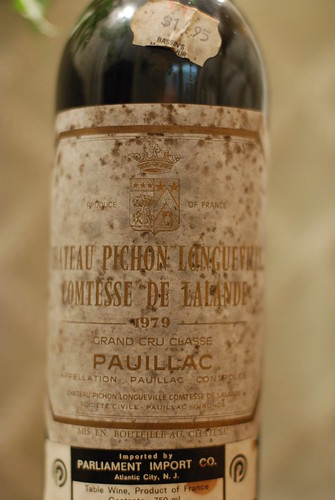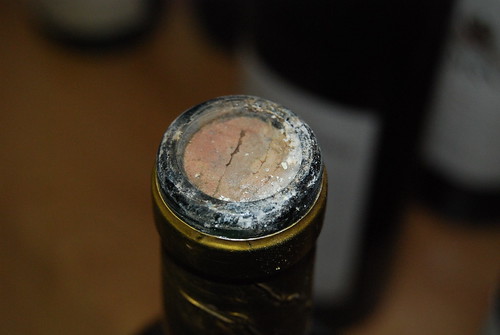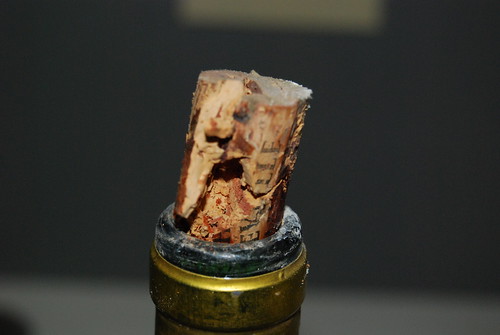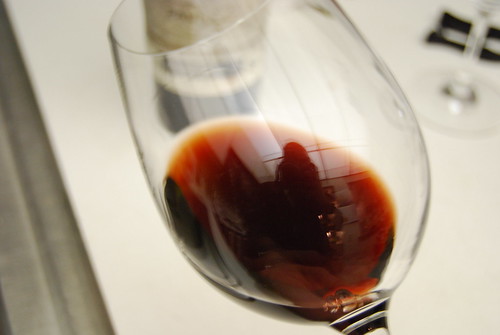Chateau Pichon Longueville Comtesse de Lalande 1979 (Pauillac)

The year the grapes for this wine were harvested was an interesting year. Revolution in the Middle East led to an energy crisis, The Police’s Roxanne was making its way to No. 32 on the Billboard charts and the U.S. Mint introduced the Susan B. Anthony dollar.
It was 1979.
I was eight years old then, and all I cared about was Star Wars and pizza. A lot can change in 27 years. And wine can be a fun way to measure those changes if you have the right bottle.
A good friend of mine is an antiques dealer, and in the not-too-distant past he picked up a few lots of mixed bottles of wine at an estate auction. From what I understand, the lots included an impressive collection Bordeaux. He had drunk almost all of the Bordeaux by the time I got the chance to see the wine, including a bottle of 1982 Chateau Lynch-Bages. He was watching the TV show Alias when someone on the show mentioned the ’82 Lynch-Bages, so he uncorked it. He didn’t know that 1982 is a legendary vintage for Bordeaux. He didn’t know that Lynch-Bages is a respectable Fifth Growth chateau or that Robert Parker rated its 1982 offering an impressive 94. For him it was more of an Alias experience than a Lynch-Bages experience—he just thought it was cool that he was drinking the same wine that was mentioned on his favorite TV show.
When I met him to go through the remainder of his stash, I spied a 1979 Pichon-Lalande still left in the box, so I liberated it. You may recall the episode of the Sopranos in which Tony and Christopher heist several cases of wine. The wine they stole from the van was the ‘86 Pichon-Lalande, which Parker scored a 94 in 2003. The ‘79 Pichon-Lalande, though, was no slouch—Parker includes it among his discussion of important ancient vintages for this chateau, calling it a “top-notch” effort and scoring it a 90.
I didn’t have high hopes for this wine, to be honest. There was no information about how it was stored all these years. Plus, although Parker said it was “fully mature” and suggested it would last until the end of 2007, I had read elsewhere that it was past its prime. 
I knew I was in trouble as soon as I peeled the foil off the cap. Mold. Further inspection revealed that the top of the cork was also wet.
“Damn,” I thought, “not good signs.” 
It only got worse. As the cork was about half-way out of the bottle, it started to crumble and tear in half. At this point, I pretty much knew it was over. Still, I removed the rest of the cork, wiped the mold off the lip of the bottle, poured the wine and let it breathe. 
While I waited, I tilted the glass and held it above the white counter-top. The wine had that signature brown hue at the edge that you only see with older clarets. It was beautiful. I soaked up as much of the color as I could, realizing that this would probably be the only rewarding part of the experience.
Eventually, I swirled the glass, drew it up to my nose and took a deep whiff. I could identify the smell immediately; it was unmistakable. But even factoring-in my low expectations, it was heartbreaking: feces and disinfectant. After a while the smell mellowed into that of a wet basement. And that’s where it stayed, even into the next day. The subtleties of lush fruit and soft tannins the wine was supposed to reveal were nowhere to be found. All that was left on the palate was vinegary acid and the feeble hint of black currant—a faded echo of what this wine perhaps once was or what it could have been.
Tainted or not, the one thing this wine delivers is perspective about how far we have come in a quarter of a century. These days, a crisis in the Middle East is affecting the cost of energy, The Police just played Roxanne at the Grammys and the U.S. Mint is trying to push a new dollar coin. Oh, how times have changed. I don’t know about you, but all of a sudden I’m the mood for Star Wars and pizza.












1 comment:
Alright - pizza's on, but are we doing Sharp Edge or Police Station?
Post a Comment